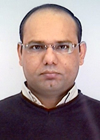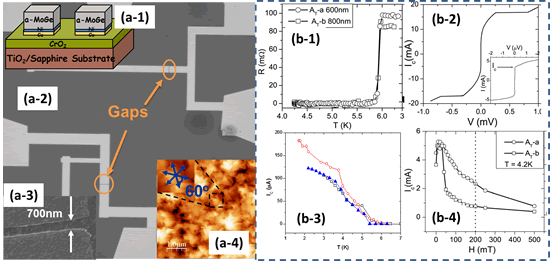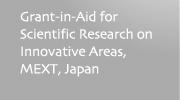
Muhammad Shahbaz ANWAR
(JSPS PD Fellow since Nov. 2014)
Researcher, Quantum Materials Lab., Department of Physics, Kyoto University
- Field of Specialty:
- Condensed Matter Physics (Experiment), Spin Transport
- Topics of Research:
- (A01) Novel Edge Phenomena in Superconductors with Broken Time-Reversal Symmetry
■ Laboratory Website
RESEARCH
I have investigated the generation of spin triplet superconductivity at the interface of a conventional superconductor and a half metallic ferromagnet CrO2, which leads to a long-ranged proximity effect. Conventional spin-singlet Cooper pairs dephase in a ferromagnet under the effect of its exchange field over a coherence length, which cannot be more that few nm. However, such a dephasing does not occur with spin triplet Cooper pair. The triplet correlations can be induced at a superconductor / ferromagnet (S/F) interface via some sort of magnetic inhomogeneity, for instance domain walls or unaligned magnetic moments.
CrO2-based S/F/S devices were fabricated using a-MoGe superconductor in lateral geometry with a spacing of 700 nm (Fig. a). Long ranged supercurrents are observed when the devises are fabricated on sapphire substrates. But in case of TiO2 substrates, we do not find supercurrents. CrO2 can be grown only via Chemical Vapor Deposition on few selected substrates like sapphire or TiO2. On sapphire it grows in the form of rectangular grains aligned at 60o degree to each other. The resulting magnetic anisotropy is providing a required inhomogeneity to generate long-ranged supercurrents. While on TiO2 the grains have two-fold rotational symmetry and uniaxial anisotropy, which cannot provide required magnetic inhomogeneity. To solve this problem, we create artificial magnetic inhomogeneity by sputtering another ferromagnetic thin layer of Ni over CrO2. In this way we observed rather strong proximity effect over the length of 800 nm (Fig. b).

In this topological quantum phenomena project, I am planning to investigate the Josephson effects based Sr2RuO4, which is most probably a chiral p-wave spin triplet superconductor. We prepare conventional-superconductor/Ru/Sr2RuO4 junctions to investigate the interference between a conventional s-wave spin singlet superconductor and a chiral p-wave spin triplet superconductor. It has been realized that such a superconducting interference exhibits topological nature. The chiral p-wave superconductivity of Sr2RuO4 may even generate a half quantum vortex. It has been found that Sr2RuO4 exhibits a half fluxoid jumps from magnetic torque measurements. We will also fabricate micrometer-sized rings of Sr2RuO4to confirm the half fluxoid generation using transport phenomena.
EDUCATION
- 2001
- BSc, Punjab University-Pakistan
- 2006
- MSc+M.Phil, University of Engineering and Technology Lahore-Pakistan
- 2011 Ph.D., Leiden University (Advisor: Prof. Dr. Jan Aarts)
PROFESSIONAL EXPERIENCE
- 2004-2007
- Lecturer, University of Engineering and Technology Lahore-Pakistan
PUBLICATIONS RELATED TO THIS PROJECT
"Ferromagnetic SrRuO3 thin-film deposition on a spin-triplet superconductor Sr2RuO4
with a highly conducting interface",
M. S. Anwar, Y. J. Shin, S. R. Lee, S. J. Kang, Y. Sugimoto, S. Yonezawa, T. W. Noh, Y. Maeno,
Applied Physics Express 8, 015502-1-5 (Dec. 2014).
.
"Anomalous switching in Nb/Ru/Sr2RuO4 topological junctions by chiral domain wall motion",
M. S. Anwar, T. Nakamura, S. Yonezawa, M. Yakabe, R. Ishiguro, H. Takayanagi, & Y. Maeno,
Scientific Reports 3, 2480-1-6 (Aug. 2013).
SELECTION OF PUBLICATIONS
"Long range supercurrents in ferromagnetic CrO2 using a multilayer contact structure",
M. S. Anwar, M. Veldhorst, A. Brinkman, and J. Aarts
Appl. Phys. Lett. 100, 052602 (2012).
"Inducing supercurrents in thin films of ferromagnetic CrO2",
M. S. Anwar, and J. Aarts,
Supercond. Sci. Technol. 24, 024016 (2011).
"Long range supercurrents through half-metallic ferromagnetic CrO2",
M. S. Anwar, F. Czeschka, M. Hesselberth, M. Porcu, J. Aarts,
Phys. Rev. B. 82, 100501(R) (2010).
"Influence of number of laser shots on laser induced microstructures on Ag and Cu target",
A Latif, M. S. Anwar,M. A. Aleem, M. S. Rafique, M. Khaleeq-ur-Rahman,
Laser Part. Beams. 27,129 (2009).
"Laser Induced Exfoliation Splashing in Glass Materials",
M. Khaleeq-ur-Rahman, M. S. Anwar,M. S. Rafique, and K. W. Haider,
Nucl. Inst. and Meth.B 255, 338 (2007).
"Theoretical model for heat conduction in metals during interaction with ultra short laser pulse",
M. S. Anwar, A. Latif, M. Iqbal, M. S. Rafique, M. Khaleeq-ur-Rahman and S. Siddique,
Laser Part. Beams 24, 347 (2006).
"Angular distribution and forward peaking in laser produced plasma ions",
M. S. Rafique, M. Khaleeq-ur-Rahman, M. S. Anwar, F. Mahmood, A. Ashfaq and K. Siraj,
Laser Part. Beams 32, 131 (2005).

